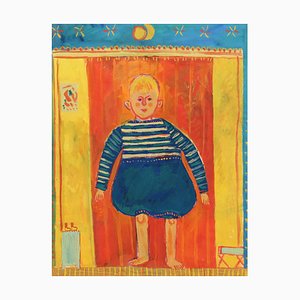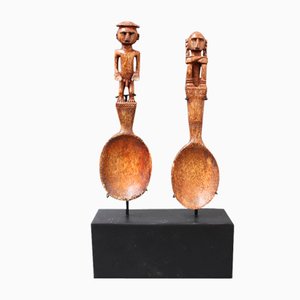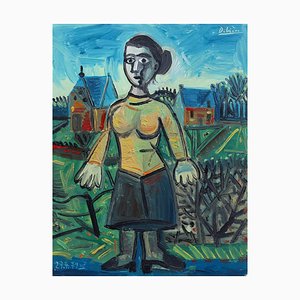Traducción generada automáticamente
Mostrar original
Mostrar traducción
Springtime in the Camargue' by Yves Brayer (circa 1960s). The Camargue region in the South of France is a stunning expanse of wetlands that boasts a unique blend of landscapes and wildlife. This area is characterised by its shallow lagoons, marshes, and mudflats, creating a vibrant ecosystem that is a haven for diverse flora and fauna as depicted here by the artist. As you wander through the Camargue, you’ll encounter expansive fields adorned with tall, swaying reeds and colourful rugs of wildflowers that bloom in the spring. The skies above are often dotted with flocks of flamingos, their striking pink plumage a dramatic contrast against the brilliant blues of the water and the greens of the surrounding vegetation. These wetlands are also home to a variety of other bird species, making it a prime spot for birdwatchers and nature enthusiasts. For these qualities, Brayer loved the Camargue region and painted it widely. The artist signed the work in the lower left hand and titled it on the reverse of the canvas. The painting is in good overall condition having been recently cleaned by an art restoration specialist and reframed with a French-style linen slip. Please enjoy the many photos accompanying this listing. About the Artist : Yves Brayer (1907-1990) was born in Versailles, France. Determined to be an artist from an early age, he set out for Paris in 1924, initially studying at the academies in Montparnasse, and from there he attended the École des Beaux-Arts. Whilst still a student he exhibited at the Salon d’Automne and the Salon des Indépendants , and in 1927 Brayer left Paris for Spain with the aid of a state grant to enable him to study the works of the Spanish Masters in the Prado. On his return to Paris in 1934 he exhibited a collection of paintings inspired by his travels in Europe and Morocco to great acclaim. Having moved south to Cordes in the Tarn region of France after the War, Brayer then discovered the area which was to have the greatest artistic influence on his work: Provence. He was enchanted by the diverse and architectural forms of the Alpilles mountains, and by the vast expanse of the Camargue region with its ubiquitous white horses and black bulls. from then on he spent several months each year working in Provence. He also made several trips to Mexico, Egypt, Iran, Greece, Russia, USA and Japan where he was quick to grasp the unique rhythm and light of each country. A large collection of Yves Brayer’s paintings are on permanent display both at the Museum of Modern and Contemporary Art in Cordes, in the Salle Yves Brayer and at the Musée Yves Brayer in Les Baux de Provence, as well as various museums in France and elsewhere. Brayer passed away in 1990. His artworks are an investment. Bids at the international auction houses continue to advance as appreciation for his work mounts. Some of the artist's oil paintings are now selling for tens of thousands of dollars. Dimensions with frame : H 62 cm / 24.4" W 77.5 cm / 30.5" Dimensions without frame : H 50 cm / 19.7" W 65 cm / 25.6"
Primavera en la Camarga", de Yves Brayer (años sesenta). La región de la Camarga, en el sur de Francia, es una impresionante extensión de humedales que ofrece una mezcla única de paisajes y vida salvaje. Esta zona se caracteriza por sus lagunas poco profundas, pantanos y marismas, que crean un vibrante ecosistema que sirve de refugio a una flora y fauna diversas, tal y como las representa aquí el artista. Al pasear por la Camarga, encontrará extensos campos adornados con altos juncos que se mecen y coloridas alfombras de flores silvestres que florecen en primavera. Los cielos suelen estar salpicados de bandadas de flamencos, cuyo llamativo plumaje rosa contrasta con los azules brillantes del agua y los verdes de la vegetación circundante. Estos humedales también albergan una gran variedad de otras especies de aves, lo que los convierte en un lugar privilegiado para los observadores de aves y los entusiastas de la naturaleza. Por estas cualidades, Brayer amaba la región de la Camarga y la pintó ampliamente. El artista firmó la obra en la parte inferior izquierda y la tituló en el reverso del lienzo. El cuadro está en buen estado en general, ya que ha sido limpiado recientemente por un especialista en restauración de obras de arte y enmarcado con un engobe de lino al estilo francés. Disfrute de las numerosas fotos que acompañan este anuncio. Sobre el Artista : Yves Brayer (1907-1990) nació en Versalles, Francia. Decidido a ser artista desde muy joven, se trasladó a París en 1924, estudiando inicialmente en las academias de Montparnasse, y desde allí asistió a la École des Beaux-Arts. Durante su época de estudiante, expuso en el Salón de Otoño y en el Salón de los Independientes. En 1927, Brayer viajó a España con la ayuda de una beca estatal que le permitió estudiar las obras de los maestros españoles en el Museo del Prado. A su regreso a París, en 1934, expone con gran éxito una colección de cuadros inspirados en sus viajes por Europa y Marruecos. Tras la guerra, Brayer se traslada al sur de Francia, a Cordes, en la región del Tarn, y descubre la región que más influirá en su obra artística: La Provenza. Encantado por la diversidad de formas arquitectónicas de los Alpilles y por la inmensidad de la Camarga, con sus omnipresentes caballos blancos y toros negros, Brayer pasó varios meses al año trabajando en la Provenza. También realizó varios viajes a México, Egipto, Irán, Grecia, Rusia, Estados Unidos y Japón, donde captó rápidamente el ritmo y la luz únicos de cada país. Una gran colección de cuadros de Yves Brayer se expone permanentemente en el Museo de Arte Moderno y Contemporáneo de Cordes, en la Sala Yves Brayer y en el Museo Yves Brayer de Les Baux de Provence, así como en diversos museos de Francia y otros países. Brayer falleció en 1990. Sus obras son una inversión. Las pujas en las casas de subastas internacionales siguen subiendo a medida que aumenta el aprecio por su obra. Algunos óleos del artista se venden ahora por decenas de miles de dólares. Dimensiones con marco : Alto 62 cm / 24,4" Ancho 77,5 cm / 30,5" Dimensiones sin marco : Alto 50 cm / 19,7" Ancho 65 cm / 25,6"




















Contacta con nosotros
Haz una oferta
¡Hemos notado que eres nuevo en Pamono!
Por favor, acepta los Términos y condiciones y nuestra Política de privacidad
Contacta con nosotros
Haz una oferta
¡Ya casi está!
Para seguir la conversación en la plataforma, por favor completa el registro. Para proceder con tu oferta en la plataforma, por favor completa el registro.Exitoso
Gracias por tu consulta, alguien de nuestro equipo se pondrá en contacto contigo en breve.
Si eres profesional del diseño, por favor solicita aquí los beneficios del Programa comercial de Pamono